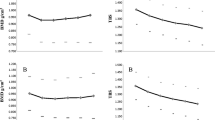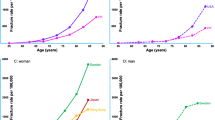Abstract
The prevalence and severity of spine degenerative changes have been noted to be lower among older Chinese women than among older Caucasian women. Spine degenerative changes associated with marginal osteophytosis, trabecular thickening, subchondral sclerosis, facet joint arthrosis, and disc space narrowing can all lead to artificially higher spine areal bone mineral density (BMD). The lower prevalence and severity of spine degeneration have important implications for the interpretation of spine areal BMD reading for Chinese women. With fewer contributions from spine degenerative changes, following natural aging, the declines of population group means of spine BMD and T-score are faster for Chinese women than for Caucasian women. While a cutpoint T-score ≤ −2.5 for defining spine densitometric osteoporosis is recommended for Caucasian women, for Chinese women the same cutpoint T-score of ≤ −2.5 inflates the estimated osteoporosis prevalence based on spine BMD measure. In addition to the use of an ethnicity-specific BMD reference database, a stricter cutpoint T-score for defining spine densitometric osteoporosis among older Chinese women should be applied.



Similar content being viewed by others
References
Mailis-Gagnon A, Yegneswaran B, Nicholson K, Lakha SF, Papagapiou M, Steiman AJ, Ng D, Cohodarevic T, Umana M, Zurowski M. Ethnocultural and sex characteristics of patients attending a tertiary care pain clinic in Toronto. Ontario. Pain Res Manag. 2007;12:100–6.
Meana M, Cho R, DesMeules M, Chronic pain. The extra burden on Canadian Women. BMC Womens Health. 2004;4(Suppl 1):S17.
Deyo RA, Mirza SK, Martin BI. Back pain prevalence and visit rates: estimates from U.S. national surveys, 2002. Spine. 1976;2006(31):2724–7.
Waterman BR, Belmont PJ Jr, Schoenfeld AJ. Low back pain in the United States: incidence and risk factors for presentation in the emergency setting. Spine J. 2012;12:63–70.
Wáng YXJ, Diacinti D, Leung JCS, Iannacone A, Kripa E, Kwok TCY, Diacinti D. Much lower prevalence and severity of radiographic osteoporotic vertebral fracture in elderly Hong Kong Chinese women than in age-matched Rome Caucasian women: a cross-sectional study. Arch Osteoporos. 2021;16:174.
Wang YX, Deng M, Griffith JF, Kwok AWL, Leung JCS, Lam PMS, Yu BWM, Leung PC, Kwok TCY. ‘Healthier Chinese spine’: an update of osteoporotic fractures in men (MrOS) and in women (MsOS) Hong Kong spine radiograph studies. Quant Imaging Med Surg. 2022;12:2090–105.
Wáng YXJ. The definition of spine bone mineral density (BMD)-classified osteoporosis and the much inflated prevalence of spine osteoporosis in older Chinese women when using the conventional cutpoint T-score of -2.5. Ann Transl Med. 2022;10:1421.
So TY, Diacinti D, Leung JCS, Iannacone A, Kripa E, Kwok TCY, Diacinti D, Wang YXJ. Lower prevalence and severity of degenerative changes in the lumbar spine in elderly Hong Kong Chinese compared with age-matched Italian Caucasian women. Spine. 2022;(47):1710–8.
Wang YXJ, Diacinti D, Iannacone A, Kripa E, Diacinti D, Kwok TCY. Radiographic degeneration features of older Chinese and older Italian Caucasian women with a focus on thoracic spine. European Society of Musculoskeletal Radiology annual meeting. 2023; abstract No. 23ESSRABS0309
Yoshimura N, Dennison E, Wilman C, Hashimoto T, Cooper C. Epidemiology of chronic disc degeneration and osteoarthritis of the lumbar spine in Britain and Japan: a comparative study. J Rheumatol. 2000;27:429–33.
World Health Organization. Assessment of fracture risk and its application to screening for postmenopausal osteoporosis: report of a WHO study group [meeting held in Rome from 22 to 25 June 1992]. WHO. 1994;
Looker AC, Borrud LG, Hughes JP, Fan B, Shepherd JA, Melton LJ 3rd. Lumbar spine and proximal femur bone mineral density, bone mineral content, and bone area: United States, 2005-2008. Vital and health statistics. Series 11. NHS. 2012;251:1–132.
Masud T, Langley S, Wiltshire P, Doyle DV, Spector TD. Effect of spinal osteophytosis on bone mineral density measurements in vertebral osteoporosis. BMJ. 1993;307:172–3.
Salo S, Leinonen V, Rikkonen T, Vainio P, Marttila J, Honkanen R, Tuppurainen M, Kröger H, Sirola J. Association between bone mineral density and lumbar disc degeneration. Maturities. 2014;79:449–55.
Muraki S, Yamamoto S, Ishibashi H, Horiuchi T, Hosoi T, Orimo H, Nakamura K. Impact of degenerative spinal diseases on bone mineral density of the lumbar spine in elderly women. Osteoporos Int. 2004;15:724–8.
Pye SR, Reid DM, Adams JE, Silman AJ, O’Neill TW. Radiographic features of lumbar disc degeneration and bone mineral density in men and women. Ann Rheum Dis. 2006;65:234–8.
Wu XP, Liao EY, Huang G, Dai RC, Zhang H. A comparison study of the reference curves of bone mineral density at different skeletal sites in native Chinese, Japanese, and American Caucasian women. Calcif Tissue Int. 2003;73:122–32.
Iki M, Kagamimori S, Kagawa Y, Matsuzaki T, Yoneshima H, Marumo F. Bone mineral density of the spine, hip and distal forearm in representative samples of the Japanese female population: Japanese Population- Based Osteoporosis (JPOS) Study. Osteoporos Int. 2001;12:529–37.
Wáng YXJ, Xiao BH. Estimations of bone mineral density defined osteoporosis prevalence and cutpoint T-score for defining osteoporosis among older Chinese population: a framework based on relative fragility fracture risks. Quant Imaging Med Surg. 2022;12:4346–60.
Wáng YXJ, Diacinti D, Leung JCS, Iannacone A, Kripa E, Kwok TCY, Diacinti D. Conversion of osteoporotic vertebral fracture severity score to osteoporosis T-score equivalent status: a framework and a comparative study of Hong Kong Chinese and Rome Caucasian older women. Arch Osteoporos. 2022;18:1.
Wáng YXJ. Around the time of a hip fracture, older East Asian female patients tend to measure lower densitometric femoral neck and total hip T-scores than older Caucasian female patients: a literature analysis. Quant Imaging Med Surg. 2023;13:2772–9.
Hoaglund FT, Yau AC, Wong WL. Osteoarthritis of the hip and other joints in southern Chinese in Hong Kong. J Bone Joint Surg Am. 1973;55:545–7.
Nevitt MC, Xu L, Zhang Y, Lui LY, Yu W, Lane NE, Qin M, Hochberg MC, Cummings SR, Felson DT. Very low prevalence of hip osteoarthritis among Chinese elderly in Beijing, China, compared with whites in the United States: the Beijing osteoarthritis study. Arthritis Rheum. 2002;46:1773–9.
Zhang Y, Xu L, Nevitt MC, Niu J, Goggins JP, Aliabadi P, Yu W, Lui LY, Felson DT. Lower prevalence of hand osteoarthritis among Chinese subjects in Beijing compared with white subjects in the United States: the Beijing Osteoarthritis Study. Arthritis Rheum. 2003;48:1034–40.
Cong E, Walker MD. The Chinese skeleton: insights into microstructure that help to explain the epidemiology of fracture. Bone Res. 2014;2:14009.
Kung AW, Wu CH, Itabashi A, Lee JK, Park HM, Zhao Y, Chan WP, Kendler DL, Leib ES, Lewiecki EM, Bilezikian JP, Baim S, Asia Pacific Panel of ISCD. International Society for Clinical Densitometry official positions: Asia-Pacific Region consensus. J Clin Densitom. 2010;13:346–51.
Wáng YXJ, Leung JCS, Lam PMS, Kwok TCY. Conversion of osteoporotic-like vertebral fracture severity score to osteoporosis T-score equivalent status: a framework study for older Chinese men. Osteoporos Sarcopenia. 2023;9:14–21.
Acknowledgements
The authors thank Professor Glen Mervyn Blake, King’s College London, UK, for helpful discussions.
Author information
Authors and Affiliations
Corresponding author
Ethics declarations
Conflict of interest
The authors declare no competing interests.
Additional information
Publisher’s note
Springer Nature remains neutral with regard to jurisdictional claims in published maps and institutional affiliations.
Rights and permissions
Springer Nature or its licensor (e.g. a society or other partner) holds exclusive rights to this article under a publishing agreement with the author(s) or other rightsholder(s); author self-archiving of the accepted manuscript version of this article is solely governed by the terms of such publishing agreement and applicable law.
About this article
Cite this article
Wáng, Y.X.J., Guglielmi, G., Guermazi, A. et al. Much lower prevalence and severity of spine degenerative changes among older Chinese women than among older Caucasian women and its implication for the interpretation of lumbar spine BMD T-score for Chinese women. Skeletal Radiol 53, 247–251 (2024). https://doi.org/10.1007/s00256-023-04419-z
Received:
Revised:
Accepted:
Published:
Issue Date:
DOI: https://doi.org/10.1007/s00256-023-04419-z




